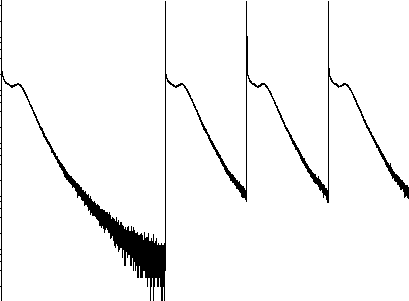ChopData v1¶
Summary¶
Splits an input workspace into a grouped workspace, where each spectra if ‘chopped’ at a certain point (given in ‘Step’ input value) and the X values adjusted to give all the workspace in the group the same binning.
See Also¶
Properties¶
Name |
Direction |
Type |
Default |
Description |
|---|---|---|---|---|
InputWorkspace |
Input |
Mandatory |
Name of the input workspace to be split. |
|
OutputWorkspace |
Output |
WorkspaceGroup |
Mandatory |
Name for the WorkspaceGroup that will be created. |
Step |
Input |
number |
20000 |
|
NChops |
Input |
number |
5 |
|
IntegrationRangeLower |
Input |
number |
Optional |
|
IntegrationRangeUpper |
Input |
number |
Optional |
|
MonitorWorkspaceIndex |
Input |
number |
Optional |
Description¶
This algorithm will chop the input workspace into equally sized workspaces, and adjust the X-values given so that they all begin from the same point. This is useful if your raw files contain multiple frames.
Identifying Extended Frames¶

Figure 1: Example Monitor Spectrum with Extended Frames¶
If the parameters IntegrationRangeLower, IntegrationRangeUpper and MonitorWorkspaceIndex are provided to the algorithm, then it will attempt to identify where in the workspace the frames have been extended.
For example: looking at Figure 1 which shows an input workspace covering 100000 microseconds, we can see that the first frame covers forty thousand, and the other three cover twenty thousand each.
In order for Mantid to determine this programmatically, it integrates over a range (defined by IntegrationRangeLower and IntegrationRangeUpper) for each “chop” of the data. If the relative values for this integration fall within certain bounds, then the chop is deemed to be a continuation of the previous one rather than a separate frame. If this happens, then they will be placed in the same workspace within the result group.
The algorithm will only look at the workspace given in MonitorWorkspaceIndex property to determine this. Though it is expected and recommended that you use a monitor spectrum for this purpose, it is not enforced so you may use a regular detector if you have cause to do so.
Usage¶
Example - Roughly Chop Workspace
Note
To run these usage examples please first download the usage data, and add these to your path. In Mantid this is done using Manage User Directories.
# Creates a dummy ws with a single spectrum with 100 bins. There is exactly 1 count in every bin.
ws = CreateSampleWorkspace("Histogram", "Flat background", NumBanks=1, BankPixelWidth=1)
time_diff = (ws.readX(0)[99] - ws.readX(0)[0])
# Chop the workspace roughly in two.
result = ChopData(ws, NChops=2, Step=time_diff/2)
print("The time range of the original workspace was {:.0f}.".format(time_diff))
print("The number of bins in the original workspace was {}.".format(ws.blocksize()))
print("The number of bins in the 1st chop is {}.".format(result[0][0].blocksize()))
print("The number of bins in the 2nd chop is {}.".format(result[0][1].blocksize()))
Output:
The time range of the original workspace was 19800.
The number of bins in the original workspace was 100.
The number of bins in the 1st chop is 48.
The number of bins in the 2nd chop is 48.
Categories: AlgorithmIndex | Transforms\Splitting
Source¶
C++ header: ChopData.h
C++ source: ChopData.cpp